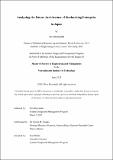Analyzing the Future Architecture of Steelmaking Enterprise in Japan
Author(s)
Kawasaki, Toru
DownloadThesis PDF (3.348Mb)
Advisor
Rhodes, Donna H.
Terms of use
Metadata
Show full item recordAbstract
The steel industry in Japan has supported the development of the Japanese economy together with Japanese domestic consumers, especially automobile companies, and NSC has built a sophisticated business system architecture. However, the environment surrounding the company and the needs of its stakeholders are rapidly changing, and NSC is faced with the need to transform its architecture. This study utilizes the ARIES framework to examine the strategy that NSC should adopt to pursue profitability, development, and efficiency for sustainable growth from an organizational design perspective.
The objective of this study is to investigate the steelmaking enterprise against landscape changes and stakeholder needs and to generate resilient alternative architectures that are compatible with the NSC context. Furthermore, alternative architectures are evaluated in the context of several extreme scenarios, such as the rapid development of decarbonization technologies. The results indicate that a data-driven alternative architecture that brings together a new digital technology-savvy workforce within the company and a new HR department to manage this group may be the most rational option for NSC. Finally, this thesis provides an implementation plan for NSC's architectural team. The methodology of this study can be applied to other overseas steel mills, such as AM/NS India and G/GJ Steel, where NSC is expanding its operations, and identifies approaches that enable the steel industry to succeed in sustainable development in times of rapid change, including the development of decarbonization and digital technologies.
Date issued
2023-06Department
System Design and Management Program.Publisher
Massachusetts Institute of Technology